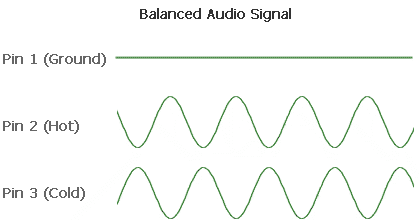Balanced Audio Cables

Balanced audio cables use an extra line, and consist of a hot line (positive), cold line (negative) and earth. The audio signal is transmitted on both the hot and cold lines, but the voltage in the cold line is inverted (i.e. the polarity is changed) so it is negative when the hot signal is positive. These two signals are often referred to as being 180 degrees out of phase with each other but this is technically incorrect — the signals are not actually out of phase, they are opposite polarities, i.e. one signal is effectively flipped upside down rather than being delayed 180°. This confusion could be due to the fact that in a graphical representation of a sine wave (pictured below) the effect of changing polarity and changing the phase 180° looks the same.

When the cable is plugged into an input (on a mixer or other equipment) the hot and cold signals are combined. Normally you would expect these two signals to cancel each other out, but at the input stage the inversion is reversed before being merged together, so they actually combine to form a stronger signal.
Removing Noise
Along the length of the cable, noise can be introduced from external sources such as power cables, RF interference, etc. This noise will be identical on both hot and cold lines. This is known as a common mode signal - a signal which appears equally on both conductors of a two wire line.
So the hot and cold lines carry two signals: A desirable audio signal which has an opposite voltage on each line, and unwanted noise which is the same on both lines.
This is where the trick of balanced audio kicks in. At the input stage when the inverted audio signal is re-inverted to make both desirable audio signals the same, the unwanted noise is inverted. Voila - all the unwanted noise is cancelled out, leaving only the combined original signal.
Note: For more information about sound phasing read Sound Wave Interactions, but note that sound wave phase interference is different from audio signal inverting.
Next Page: Combining Balanced Connections